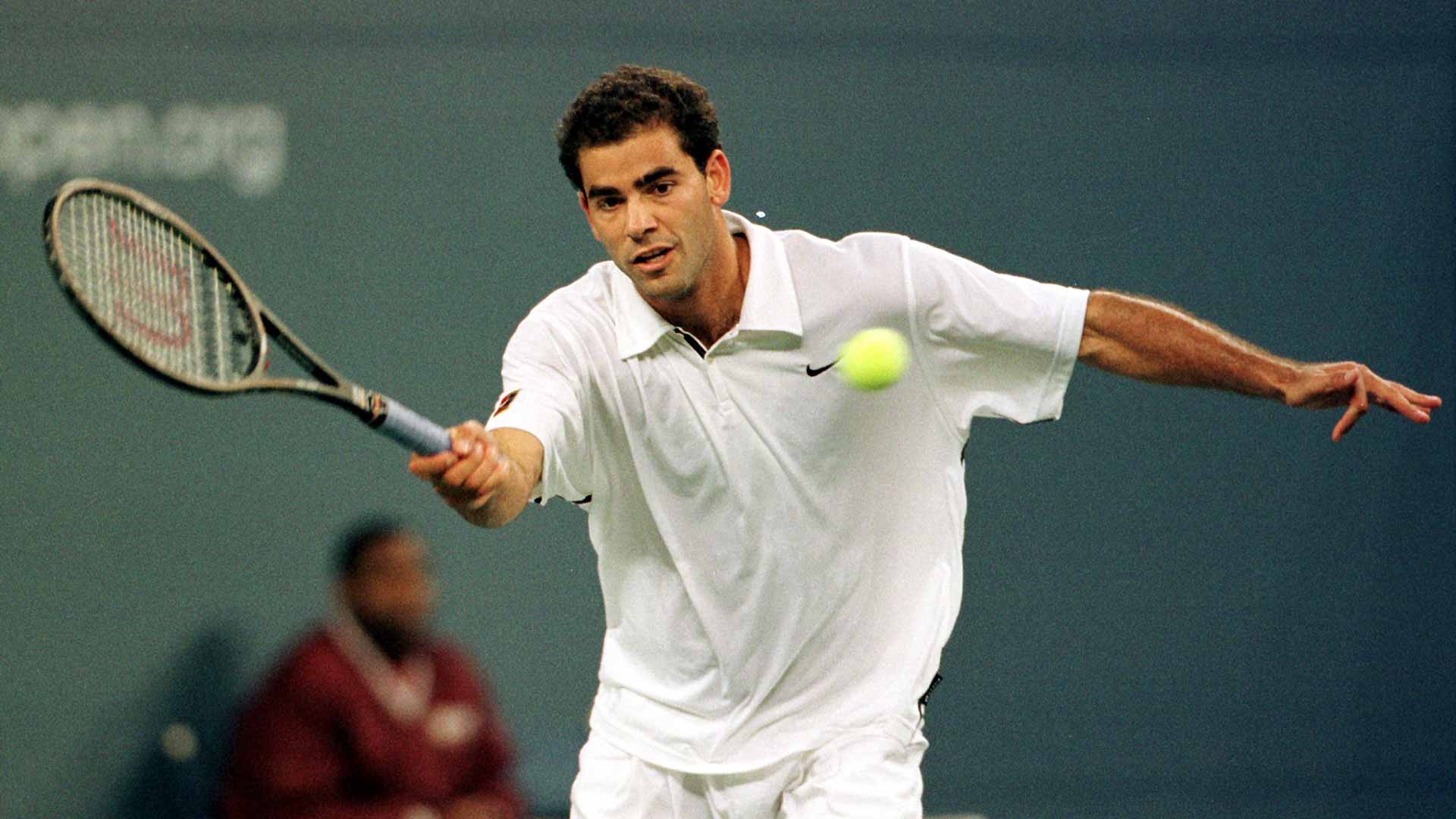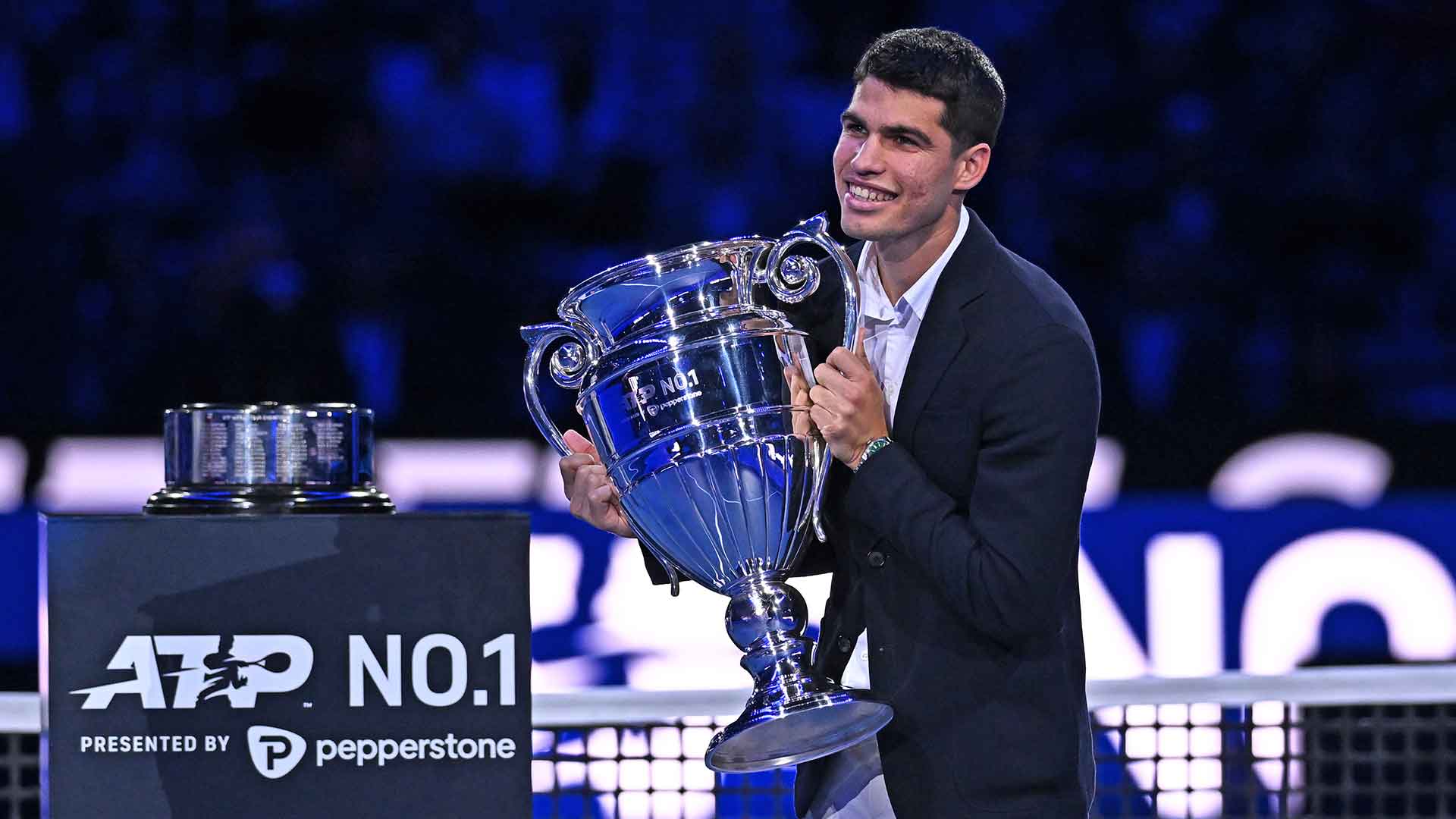First Among Equals: World No. 1 Record Breakers & Shakers
First Among Equals: World No. 1 Record Breakers & Shakers
From Novak Djokovic’s record seven year-end No. 1 presented by Pepperstone finishes to Roger Federer’s 237 consecutive weeks at No. 1, several ATP Tour stars have smashed the record books at the top of the Pepperstone ATP Rankings.
ATPTour.com continues to celebrate the 50th anniversary of the Pepperstone ATP Rankings by providing a lens on some of the most historic World No. 1 achievements.
 Novak Djokovic” style=”width:;” />
Novak Djokovic” style=”width:;” />
Photo Credit: Getty Images/ATP Tour
Year-End ATP No. 1 Presented By Pepperstone
Novak Djokovic made history on 6 November 2021 when he secured the year-end No. 1 presented by Pepperstone for a record seventh time, eclipsing the mark he previously shared with Pete Sampras. Djokovic, who ended the season atop of tennis’ mountain for the first time in 2011, lifted at least one major every year that he secured the year-end No. 1 (also 2011-12, ’14-15, ’18 and 20).
“Just proud and extremely happy. Obviously that was one of the biggest goals and it’s always one of the biggest goals, to try to be No. 1 and end the season as No. 1,” Djokovic said at the time. “To do it for the record seventh time and surpass my childhood idol and role model, Pete, is incredible. Very grateful, very blessed to be in this position.”
The lowest he fell since first rising to No. 1 came in May 2018 when he dropped to No. 22, spending a total of six weeks outside the Top 20. The Serbian, who missed the second half of the 2017 season with an elbow injury, held a 6-6 record across the first five months of the 2018 season. He ended the year strongly, though, clinching four tour-level titles, including Grand Slam crowns at Wimbledon and the US Open, resulting in him ending the year ranked No. 1 for the fifth time.
Djokovic’s most successful season came in 2015 when he tallied a 82-6 record. The Serbian lifted trophies at the Australian Open, Wimbledon and US Open that year and reached the Roland Garros final. He also won six ATP Masters 1000 crowns and the Nitto ATP Finals title in 2015.
While Djokovic holds the ATP record of seven year-end No. 1 finishes, Sampras remains the only player in the history of the Pepperstone ATP Rankings to own six consecutive year-end No. 1 finishes.
After Sampras secured the year-end No. 1 for the first time in 1993, Jimmy Connors’ five straight year-end No. 1 finishes between 1974 and 1978 kept the American hungry in the 1990s. Aiming for a record sixth consecutive year-end No. 1 finish in 1998, Sampras was seriously challenged for the top spot. He added six tournaments — Basel, Vienna, Lyon, Stuttgart, Paris and Stockholm — to his schedule between the US Open and ATP Tour World Championships [now named Nitto ATP Finals] in a bid to finish year-end No. 1. Marcelo Rios, his nearest challenger, who’d spent six weeks at the summit earlier in the year, did likewise, travelling from Munich, Singapore and Santiago, before flying back to Europe in search of rankings points.
Come the season finale in Hanover, Rios’ chances were scuppered by a back injury and on 26 November 1998, Sampras, aged 27, found out that he’d secured year-end No. 1 for the sixth straight year while eating pasta back at the hotel.
Overall, 18 players have secured the year-end No. 1 presented by Pepperstone.
| Player | Years |
| 1) Novak Djokovic | 7 |
| 2) Pete Sampras | 6 |
| 3T) Jimmy Connors | 5 |
| 3T) Roger Federer | 5 |
| 3T) Rafael Nadal | 5 |
 Pete Sampras” style=”width: 100%;” />
Pete Sampras” style=”width: 100%;” />
Pete Sampras, who holds the record for six consecutive year-end No. 1 finishes, spent a total of 286 weeks at No.1, trailing Novak Djokovic and Roger Federer. Photo Credit: STAN HONDA/AFP via Getty Images
Most Weeks At No. 1
In July 2011, Djokovic downed Rafael Nadal in the Wimbledon final to capture his first title at the grass-court major. The Serbian’s run lifted him to No. 1 in the Pepperstone ATP Rankings for the first time on 4 July 2011. Twelve years on and the 36-year-old has spent a record 389 weeks at No. 1, 79 weeks more than second-placed Roger Federer (310). In February 2023, the Serbian achieved another historic milestone, overtaking Stefanie Graf’s (377 weeks) record for most weeks by a men’s or women’s tennis player as World No. 1.
Djokovic broke Federer’s record for most weeks at No. 1 on 8 March 2021, holding top spot in the rankings across nine different stints. Since first rising to No. 1, Djokovic has captured 20 majors and 29 ATP Masters 1000 titles. Half of the players in the Top 10 when Djokovic first rose to No. 1 have since retired: Roger Federer, Robin Soderling, David Ferrer, Mardy Fish, Tomas Berdych and Andy Roddick.
Djokovic spent 122 consecutive weeks at the summit of the Pepperstone ATP Rankings between 7 July 2014 and 6 November 2016. This was his longest streak at No. 1.
| Player | Weeks |
| 1) Novak Djokovic | 389 |
| 2) Roger Federer | 310 |
| 3) Pete Sampras | 286 |
| 4) Ivan Lendl | 270 |
| 5) Jimmy Connors | 268 |
 Roger Federer” style=”width: 100%;” />
Roger Federer” style=”width: 100%;” />
Roger Federer celebrates winning the Australian Open in 2018. The Swiss star spent 237 consecutive weeks at No. 1. Photo Credit: Peter Staples/ATP Tour
Most Consecutive Weeks At No. 1
While Djokovic has spent the most weeks at No. 1, Federer holds the record for the number of consecutive weeks in top spot with 237. The longest uninterrupted No. 1 reign in Pepperstone ATP Rankings history began on 2 February 2004, when Federer dethroned Andy Roddick from No. 1 with his triumph at the Australian Open. He then embarked on an unprecedented period of dominance on the ATP Tour, remaining at No. 1 until 17 August 2008, when he was usurped by Nadal.
In the 237 consecutive weeks Federer spent at No. 1, he lifted 43 tour-level trophies, including 10 majors and three Nitto ATP Finals crowns.
Prior to Federer’s historic run, Jimmy Connors held the record for the most consecutive weeks. The American climbed to No. 1 for the first time on 29 June 1974 and was not displaced until 23 August 1977, spending 160 consecutive weeks at No. 1.
But it could have been so much longer.
Connors lost the five-set 1977 Wimbledon final to Bjorn Borg, with the Swede at the time calling himself the unofficial No. 1 “for the moment”. Borg officially rose to No. 1 almost two months after the Wimbledon final, but stayed there for just one week before Connors wrestled back the mantle and held it for another 84 weeks. Had the American not been displaced for one week, his reign would have been 245 weeks, a record that would still be standing today.
The American enjoyed a total of nine stints at the top, with his final one coming in June 1983, when he enjoyed a three-week period at No. 1. Connors’ record streak of 160 weeks stood for 29 years, with Federer beginning his 161st consecutive week at No. 1 on 26 February 2007.
Connors was ranked in the world’s year-end Top 10 on 16 occasions between 1973 and 1988, and his five year-end No. 1 equals those of Federer and Nadal.
“There is only one No. 1,” Connors said. “It’s a lonely spot, but it has got the best view of all… Being No. 2 is like being No. 200.”
| Player | Weeks |
| 1) Roger Federer | 237 |
| 2) Jimmy Connors | 160 |
| 3) Ivan Lendl | 157 |
| 4) Novak Djokovic | 122 |
| 5) Pete Sampras | 102 |
 Carlos Alcaraz” style=”width: 100%;” />
Carlos Alcaraz” style=”width: 100%;” />
Carlos Alcaraz with the year-end ATP No. 1 Trophy presented by Pepperstone in 2022. Photo Credit: Corinne Dubreuil/ATP Tour
Youngest No. 1s
Aged 19 years and 131 days, Alcaraz became the youngest No. 1 in Peppertone ATP Rankings history last September after winning his first Grand Slam title at the US Open. With his victory against Casper Ruud in New York, Alcaraz became the first teenage World No. 1 and fourth man from Spain to achieve the feat, joining coach Juan Carlos Ferrero, Carlos Moya and Nadal.
The then-19-year-old arrived at Flushing Meadows as the No. 4 player in the Pepperstone ATP Rankings. His leap to World No. 1 was tied for the biggest in history. Three other players have surged from No. 4 to No. 1 between one Pepperstone ATP Rankings release: Moya (15 March 1999), Andre Agassi (5 July 1999) and Sampras (11 September 2000).
Alcaraz made more history at the end of the 2022 season when he became the 18th and youngest year-end No. 1. He rose from No. 32 at the start of the season, marking the biggest jump to No. 1 in 50 editions of the year-end Pepperstone ATP Rankings.
“It means a lot to me,” Alcaraz said in Turin. “To get this trophy, the World No. 1, to be part of tennis history along with a lot of legends, for me [it] is an amazing feeling.”
Before Alcaraz, the youngest year-end No. 1 was Lleyton Hewitt. With three players in contention for No. 1 coming into the Nitto ATP Finals in November 2001, including Gustavo Kuerten and Andre Agassi, Hewitt came out on top, beating his great mate Rafter (round-robin stage), in the quest for the coveted top spot. Aged 20 years, 275 days, the Australian rose to the top for the first time after defeating Sebastien Grosjean to clinch the first of his two Nitto ATP Finals crowns (also 2002).
| Player | Age |
| 1) Carlos Alcaraz | 19 years, 131 days |
| 2) Lleyton Hewitt | 20 years, 268 days |
| 3) Marat Safin | 20 years, 298 days |
| 4) John McEnroe | 21 years, 16 days |
| 5) Andy Roddick | 21 years, 65 days |
View all 28 No. 1s in the 50-year history of the Pepperstone ATP Rankings.
Notable No. 1s In 50 Years Of Pepperstone ATP Rankings (Part 1)
Notable No. 1s In 50 Years Of Pepperstone ATP Rankings (Part 2)
Biggest Rises & Revivals In Pepperstone ATP Rankings History

